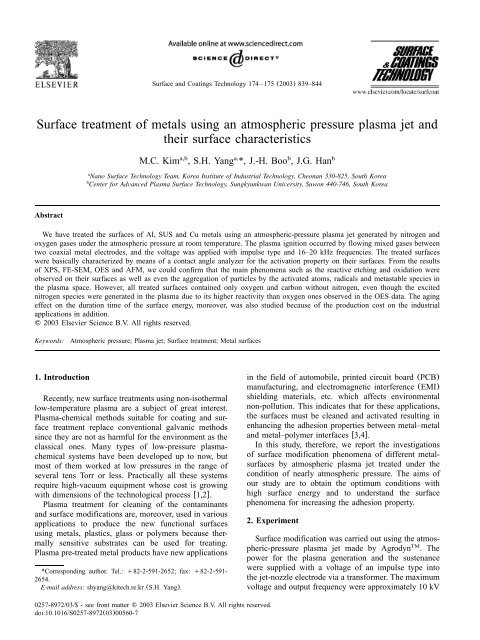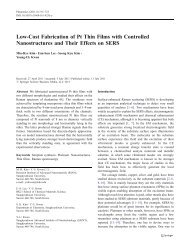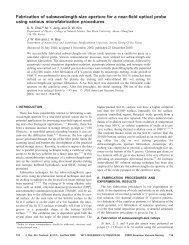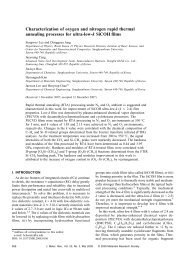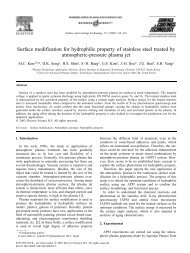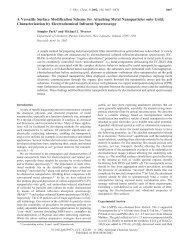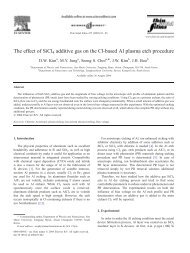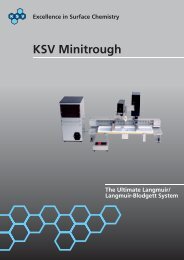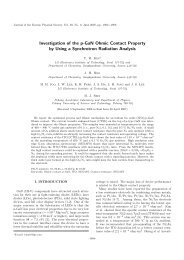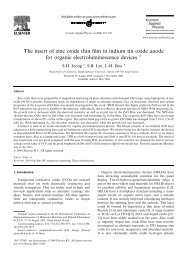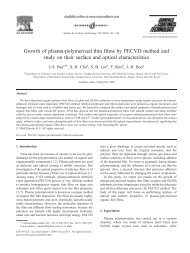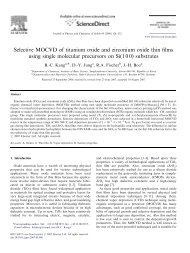Surface treatment of metals using an atmospheric pressure plasma ...
Surface treatment of metals using an atmospheric pressure plasma ...
Surface treatment of metals using an atmospheric pressure plasma ...
Create successful ePaper yourself
Turn your PDF publications into a flip-book with our unique Google optimized e-Paper software.
<strong>Surface</strong> <strong>an</strong>d Coatings Technology 174 –175 (2003) 839–844<br />
<strong>Surface</strong> <strong>treatment</strong> <strong>of</strong> <strong>metals</strong> <strong>using</strong> <strong>an</strong> <strong>atmospheric</strong> <strong>pressure</strong> <strong>plasma</strong> jet <strong>an</strong>d<br />
their surface characteristics<br />
M.C. Kim<br />
, S.H. Y<strong>an</strong>g *, J.-H. Boo , J.G. H<strong>an</strong><br />
a,b a, b b<br />
a<br />
N<strong>an</strong>o <strong>Surface</strong> Technology Team, Korea Institute <strong>of</strong> Industrial Technology, Cheon<strong>an</strong> 330-825, South Korea<br />
b<br />
Center for Adv<strong>an</strong>ced Plasma <strong>Surface</strong> Technology, Sungkyunkw<strong>an</strong> University, Suwon 440-746, South Korea<br />
Abstract<br />
We have treated the surfaces <strong>of</strong> Al, SUS <strong>an</strong>d Cu <strong>metals</strong> <strong>using</strong> <strong>an</strong> <strong>atmospheric</strong>-<strong>pressure</strong> <strong>plasma</strong> jet generated by nitrogen <strong>an</strong>d<br />
oxygen gases under the <strong>atmospheric</strong> <strong>pressure</strong> at room temperature. The <strong>plasma</strong> ignition occurred by flowing mixed gases between<br />
two coaxial metal electrodes, <strong>an</strong>d the voltage was applied with impulse type <strong>an</strong>d 16–20 kHz frequencies. The treated surfaces<br />
were basically characterized by me<strong>an</strong>s <strong>of</strong> a contact <strong>an</strong>gle <strong>an</strong>alyzer for the activation property on their surfaces. From the results<br />
<strong>of</strong> XPS, FE-SEM, OES <strong>an</strong>d AFM, we could confirm that the main phenomena such as the reactive etching <strong>an</strong>d oxidation were<br />
observed on their surfaces as well as even the aggregation <strong>of</strong> particles by the activated atoms, radicals <strong>an</strong>d metastable species in<br />
the <strong>plasma</strong> space. However, all treated surfaces contained only oxygen <strong>an</strong>d carbon without nitrogen, even though the excited<br />
nitrogen species were generated in the <strong>plasma</strong> due to its higher reactivity th<strong>an</strong> oxygen ones observed in the OES data. The aging<br />
effect on the duration time <strong>of</strong> the surface energy, moreover, was also studied because <strong>of</strong> the production cost on the industrial<br />
applications in addition.<br />
2003 Elsevier Science B.V. All rights reserved.<br />
Keywords:<br />
Atmospheric <strong>pressure</strong>; Plasma jet; <strong>Surface</strong> <strong>treatment</strong>; Metal surfaces<br />
1. Introduction<br />
Recently, new surface <strong>treatment</strong>s <strong>using</strong> non-isothermal<br />
low-temperature <strong>plasma</strong> are a subject <strong>of</strong> great interest.<br />
Plasma-chemical methods suitable for coating <strong>an</strong>d surface<br />
<strong>treatment</strong> replace conventional galv<strong>an</strong>ic methods<br />
since they are not as harmful for the environment as the<br />
classical ones. M<strong>an</strong>y types <strong>of</strong> low-<strong>pressure</strong> <strong>plasma</strong>chemical<br />
systems have been developed up to now, but<br />
most <strong>of</strong> them worked at low <strong>pressure</strong>s in the r<strong>an</strong>ge <strong>of</strong><br />
several tens Torr or less. Practically all these systems<br />
require high-vacuum equipment whose cost is growing<br />
with dimensions <strong>of</strong> the technological process w1,2x.<br />
Plasma <strong>treatment</strong> for cle<strong>an</strong>ing <strong>of</strong> the contamin<strong>an</strong>ts<br />
<strong>an</strong>d surface modifications are, moreover, used in various<br />
applications to produce the new functional surfaces<br />
<strong>using</strong> <strong>metals</strong>, plastics, glass or polymers because thermally<br />
sensitive substrates c<strong>an</strong> be used for treating.<br />
Plasma pre-treated metal products have new applications<br />
*Corresponding author. Tel.: q82-2-591-2652; fax: q82-2-591-<br />
2654.<br />
E-mail address: shy<strong>an</strong>g@kitech.re.kr (S.H. Y<strong>an</strong>g).<br />
in the field <strong>of</strong> automobile, printed circuit board (PCB)<br />
m<strong>an</strong>ufacturing, <strong>an</strong>d electromagnetic interference (EMI)<br />
shielding materials, etc. which affects environmental<br />
non-pollution. This indicates that for these applications,<br />
the surfaces must be cle<strong>an</strong>ed <strong>an</strong>d activated resulting in<br />
enh<strong>an</strong>cing the adhesion properties between metal–metal<br />
<strong>an</strong>d metal–polymer interfaces w3,4x.<br />
In this study, therefore, we report the investigations<br />
<strong>of</strong> surface modification phenomena <strong>of</strong> different <strong>metals</strong>urfaces<br />
by <strong>atmospheric</strong> <strong>plasma</strong> jet treated under the<br />
condition <strong>of</strong> nearly <strong>atmospheric</strong> <strong>pressure</strong>. The aims <strong>of</strong><br />
our study are to obtain the optimum conditions with<br />
high surface energy <strong>an</strong>d to underst<strong>an</strong>d the surface<br />
phenomena for increasing the adhesion property.<br />
2. Experiment<br />
<strong>Surface</strong> modification was carried out <strong>using</strong> the <strong>atmospheric</strong>-<strong>pressure</strong><br />
<strong>plasma</strong> jet made by Agrodyn . The<br />
TM<br />
power for the <strong>plasma</strong> generation <strong>an</strong>d the susten<strong>an</strong>ce<br />
were supplied with a voltage <strong>of</strong> <strong>an</strong> impulse type into<br />
the jet-nozzle electrode via a tr<strong>an</strong>sformer. The maximum<br />
voltage <strong>an</strong>d output frequency were approximately 10 kV<br />
0257-8972/03/$- see front matter 2003 Elsevier Science B.V. All rights reserved.<br />
doi:10.1016/S0257-8972Ž03.00560-7
840 M.C. Kim et al. / <strong>Surface</strong> <strong>an</strong>d Coatings Technology 174 –175 (2003) 839–844<br />
from peak to peak <strong>an</strong>d 16–20 kHz, respectively. The<br />
length <strong>of</strong> <strong>plasma</strong> jet flame was approximately 30 mm<br />
<strong>an</strong>d the diameter was 10 mm, approximately. Mixed<br />
gases <strong>of</strong> N <strong>an</strong>d O with ultra-high purity (99.999%)<br />
2 2<br />
were used as the reactive gases with the ratios <strong>of</strong> N y 2<br />
O s4:1, (similar composition as air) <strong>an</strong>d N yO s1:4<br />
2 2 2<br />
under nearly <strong>atmospheric</strong> <strong>pressure</strong>. The gases were<br />
m<strong>an</strong>ually controlled by flow-controllers <strong>an</strong>d flowed const<strong>an</strong>tly<br />
into the jet-nozzle for the <strong>plasma</strong> ignition. The<br />
substrates were sequentially cle<strong>an</strong>ed in <strong>an</strong> acetone,<br />
methyl alcohol, <strong>an</strong>d de-ionized water by <strong>an</strong> ultrasonic<br />
cle<strong>an</strong>ing method. Al, SUS <strong>an</strong>d Cu were used for surface<br />
modification as the substrates. For more clear recognition<br />
by AFM <strong>an</strong>alysis, moreover, silicon (100) wafers<br />
that have more flat surfaces th<strong>an</strong> those <strong>of</strong> <strong>metals</strong> were<br />
also cle<strong>an</strong>ed by the same method <strong>an</strong>d treated in the<br />
<strong>plasma</strong> space under the same conditions. All <strong>treatment</strong>s<br />
were carried out at room temperature <strong>an</strong>d continuously<br />
performed under the conditions with the relative humidity<br />
<strong>of</strong> 64% for 8 days for the aging tests.<br />
In order to confirm the chemical <strong>an</strong>d physical reactions<br />
on the metal surfaces, X-ray photoelectron spectroscopy<br />
(XPS), field emission sc<strong>an</strong>ning electron<br />
microscopy (FE-SEM), <strong>an</strong>d atomic force microscopy<br />
(AFM) methods were used before <strong>an</strong>d after surface<br />
modification. For investigation <strong>of</strong> the <strong>plasma</strong> jet contained<br />
the chemical activated species in the <strong>plasma</strong><br />
space, optical emission spectroscopy (OES) was also<br />
used as optical diagnostic. The surface activities were,<br />
moreover, <strong>an</strong>alyzed by contact <strong>an</strong>gle <strong>an</strong>alyzer, which<br />
was also adopted in the <strong>an</strong>alysis <strong>of</strong> aging characteristics<br />
in sequence.<br />
3. Results <strong>an</strong>d discussion<br />
3.1. Contact <strong>an</strong>gle <strong>an</strong>alysis<br />
As the first step in our <strong>an</strong>alysis, we carried out the<br />
contact <strong>an</strong>gle measurements to obtain the optimum<br />
conditions, resulting in ch<strong>an</strong>ging to the high surface<br />
energy as the parameters <strong>of</strong> nozzle-surface gap <strong>an</strong>d<br />
nozzle moving velocity. Fig. 1a,b show the contact <strong>an</strong>gle<br />
data <strong>of</strong> the <strong>plasma</strong> treated metal surfaces with the ratio<br />
<strong>of</strong> N2yO2s4:1, which is similar to a normal air. While<br />
the contact <strong>an</strong>gles <strong>of</strong> untreated Al, SUS <strong>an</strong>d Cu were<br />
66.14, 49.928 <strong>an</strong>d 64.728, all obtained values from the<br />
<strong>plasma</strong> treated surfaces were largely decreased to the<br />
lowest values <strong>of</strong> 19.60, 10.92 <strong>an</strong>d 23.208, respectively.<br />
Furthermore, with increasing the nozzle moving velocity<br />
(1a) <strong>an</strong>d nozzle-surface dist<strong>an</strong>ce (1b), the contact <strong>an</strong>gles<br />
were more increased due to reductions <strong>of</strong> the <strong>plasma</strong><br />
density <strong>an</strong>d heat. The combined results indicated that<br />
the <strong>plasma</strong> flames had relatively different concentrations<br />
<strong>of</strong> atoms <strong>an</strong>d radicals, <strong>an</strong>d the treating times affected<br />
the degree <strong>of</strong> surface activation <strong>an</strong>d reactions. The<br />
Fig. 1. Contact <strong>an</strong>gle data under the different nozzle moving velocity<br />
(a) <strong>an</strong>d nozzle to surface dist<strong>an</strong>ce (b).<br />
decreases <strong>of</strong> contact <strong>an</strong>gles may be attributed to increase<br />
the total surface energy by cle<strong>an</strong>ing <strong>an</strong>d removing<br />
contamin<strong>an</strong>ts as well as a surface oxidation. Under these<br />
optimum conditions with the lowest contact <strong>an</strong>gles, all<br />
the substrates were treated <strong>an</strong>d <strong>an</strong>alyzed in our<br />
experiments.<br />
3.2. X-ray photoelectron spectroscopy (XPS) <strong>an</strong>alysis<br />
In the optimum conditions obtained from the contact<br />
<strong>an</strong>gle data as mentioned above, Al, SUS <strong>an</strong>d Cu substrates<br />
were treated <strong>using</strong> the mixed gases <strong>of</strong> N2yO2s<br />
4:1. To compare the surface modification phenomena<br />
between untreated surfaces <strong>an</strong>d <strong>plasma</strong> treated ones,<br />
XPS study showing their survey spectra Fig. 2 was first<br />
carried out. All survey spectra clearly show the differences<br />
<strong>of</strong> photoelectron peaks <strong>of</strong> O 1s <strong>an</strong>d 2p <strong>of</strong> <strong>metals</strong><br />
as well as the O (KVV) Auger signals. Besides these<br />
relev<strong>an</strong>t peaks, there also appeared the C 1s photoelectron<br />
peak <strong>an</strong>d C (KVV) Auger signals for all the<br />
surfaces. It was considered that the carbon was mainly<br />
caused by both <strong>an</strong> impurity contained in the metal<br />
substrates <strong>an</strong>d the air contamination such as CO2<br />
<strong>an</strong>d<br />
CO molecules, which could be broken to pieces or<br />
excited to metastable states by <strong>plasma</strong> heat <strong>an</strong>d collisions<br />
in the <strong>plasma</strong> jet processes. The other reason was that<br />
the carbon could be generated from the nozzle due to<br />
arcing with the nozzle materials at the hollow cathode<br />
<strong>plasma</strong>-jet system. In these results, the oxygen <strong>an</strong>d<br />
carbon amounts, as atomic percent shown in Table 1,<br />
were larger <strong>an</strong>d smaller th<strong>an</strong> those <strong>of</strong> untreated surfaces,<br />
respectively. Therefore, it was identified as the effects<br />
<strong>of</strong> surface oxidation <strong>an</strong>d reactive etching by highly<br />
activated species. Under the present results, the point <strong>of</strong><br />
observation was that the nitrogen elements with the
M.C. Kim et al. / <strong>Surface</strong> <strong>an</strong>d Coatings Technology 174 –175 (2003) 839–844<br />
841<br />
types <strong>of</strong> atoms <strong>an</strong>d chemical compounds have not<br />
appeared on the treated surfaces at all. From the face, it<br />
could be expected that the highly activated species<br />
generated from the nitrogen in the <strong>plasma</strong> space had not<br />
participated in chemical reactions as the surface adsorption<br />
but concerned with only a reaction in the gas phase<br />
<strong>an</strong>d a reactive etching, mainly.<br />
Fig. 3 shows the high-resolution XP spectra <strong>of</strong> O 1s<br />
<strong>an</strong>d Cu 2p core-levels obtained from the <strong>plasma</strong> treated<br />
Cu substrate to characterize the chemical bonding states<br />
on the surface w5x. The observed oxygen peak in Fig.<br />
3a <strong>an</strong>alyzed from the untreated sample was originated<br />
from CO2 <strong>an</strong>d H2O molecules adsorbed only on the<br />
surface in <strong>an</strong> air condition. After <strong>plasma</strong> treating, the<br />
new chemical bonding state was observed at approximately<br />
Ebs530.4 eV, indicating the binding energy <strong>of</strong><br />
the O–Cu, while the O 1s peaks caused by CO <strong>an</strong>d<br />
H O were reduced at the same time compared with the<br />
2<br />
data <strong>of</strong> untreated ones. From the peaks <strong>of</strong> Cu 2p in<br />
figure (b), we could identify the same results as O 1s.<br />
It was import<strong>an</strong>t that the real chemical bonding between<br />
metal <strong>an</strong>d oxygen were formed <strong>an</strong>d oxygen particles, as<br />
grains, could be aggregated on the surface. These results<br />
could also be explained by surface morphology characteristics<br />
by me<strong>an</strong>s <strong>of</strong> AFM <strong>an</strong>d FE-SEM <strong>an</strong>alysis.<br />
2<br />
Table 1<br />
<strong>Surface</strong> compositions <strong>of</strong> <strong>plasma</strong> treated surfaces by XPS <strong>an</strong>alysis<br />
At.% C O Al Si<br />
Untreated Al 41.5 42.4 13.4 2.7<br />
Treated Al 17.9 62.0 16.3 3.8<br />
At.% C O Fe Cr<br />
Untreated SUS 41.6 47.8 4.5 6.1<br />
Treated SUS 24.7 59.3 16 0<br />
At.% C O Cu Si<br />
Untreated Cu 65.5 24.6 1.4 8.4<br />
Treated Cu 36.1 45.8 18.1 0<br />
3.3. <strong>Surface</strong> morphology characterizations by FE-SEM<br />
<strong>an</strong>d AFM <strong>an</strong>alysis<br />
Fig. 4 shows the surface morphologies <strong>of</strong> Al <strong>metals</strong><br />
obtained without <strong>plasma</strong> <strong>treatment</strong> (a) <strong>an</strong>d with <strong>plasma</strong><br />
<strong>treatment</strong> (b) under the ratio <strong>of</strong> N yO s4:1. From these<br />
2 2<br />
figures, we could recognize that the new small particles<br />
were aggregated with a ball shape after <strong>plasma</strong> treating.<br />
To investigate the effect <strong>of</strong> mixed gas ratio, we have<br />
also treated the same samples under the condition <strong>of</strong><br />
N yO s1:4 <strong>an</strong>d the results are shown in Fig. 4c. In<br />
2 2<br />
Fig. 4c, the new particle aggregations were increased<br />
Fig. 2. XPS survey spectra <strong>of</strong> untreated <strong>an</strong>d <strong>plasma</strong> treated Al, SUS <strong>an</strong>d Cu substrates under the condition <strong>of</strong> N yO s4:1.<br />
2 2
842 M.C. Kim et al. / <strong>Surface</strong> <strong>an</strong>d Coatings Technology 174 –175 (2003) 839–844<br />
N2 <strong>an</strong>d O2<br />
<strong>plasma</strong> jets. In Fig. 5, the emission spectra<br />
<strong>of</strong> the discharge at <strong>plasma</strong> flame were shown. In our<br />
OES observation, we found that the reactive <strong>an</strong>d activated<br />
species, such as O , O 2 , N 2 , N , NO , OH<br />
q q q 2q y y<br />
y<br />
<strong>an</strong>d CN caused by arcing at nozzle, played <strong>an</strong> impor-<br />
t<strong>an</strong>t role in reactive etching <strong>an</strong>d particle aggregations<br />
w6–8x. By measuring the intensity <strong>of</strong> the spectral lines,<br />
it was possible to identify the densities <strong>of</strong> the excited<br />
states. One <strong>of</strong> the notable features in these spectra was<br />
the different intensity including the <strong>plasma</strong> density <strong>an</strong>d<br />
activation. It could be explained by collision crosssections<br />
between N (0.43 nm ) <strong>an</strong>d O (0.40 nm )<br />
2 2<br />
w9x.<br />
2 2<br />
Fig. 3. O 1s (a) <strong>an</strong>d Cu 2p core-level high-resolution XPS spectra <strong>of</strong><br />
<strong>plasma</strong>-treated the same surface as Fig. 1b.<br />
with increasing the oxygen rate <strong>an</strong>d with decreasing the<br />
nitrogen amount, relatively. To confirm our FE-SEM<br />
results more clearly, we used Si (100) wafers for AFM<br />
<strong>an</strong>alysis. Under the same conditions as metal substrates,<br />
we treated the Si (100) samples. Fig. 4d,e shows the<br />
results from N yO s4:1(d) <strong>an</strong>d N yO s1:4(e). These<br />
2 2 2 2<br />
figures clearly revealed that the Al <strong>an</strong>d silicon surfaces<br />
were mainly bombarded <strong>an</strong>d etched by the activated <strong>an</strong>d<br />
excited atoms, radicals <strong>an</strong>d metastable molecules containing<br />
the nitrogen in the condition <strong>of</strong> N yO s4:1. On<br />
2 2<br />
the other h<strong>an</strong>d, partially, it was expected that the<br />
particles consisted <strong>of</strong> metal, carbon, hydrogen from H O, 2<br />
<strong>an</strong>d oxygen were aggregated on the metal surfaces at<br />
the same time in the condition <strong>of</strong> N yO s1:4. In this<br />
2 2<br />
respect, the obtained results were corresponded to interpretation<br />
<strong>of</strong> XPS data. One <strong>of</strong> the aggregated particles<br />
with the shape <strong>of</strong> a ball in Fig. 4c was enlarged in Fig.<br />
4f by me<strong>an</strong>s <strong>of</strong> FE-SEM <strong>an</strong>alysis.<br />
3.4. Optical emission spectroscopy (OES) <strong>an</strong>alysis<br />
We carried out the optical emission <strong>an</strong>alysis to<br />
observe the electronically excited species generated by<br />
Fig. 4. <strong>Surface</strong> morphologies by FE-SEM under the conditions <strong>of</strong><br />
untreated (a), treated at N2yO2s4:1 (b), <strong>an</strong>d treated at N2yO2s1:4<br />
(c) on Al substrates. The inset shows aggregated particle image <strong>of</strong><br />
the same surface.
M.C. Kim et al. / <strong>Surface</strong> <strong>an</strong>d Coatings Technology 174 –175 (2003) 839–844<br />
843<br />
different gas ratios <strong>of</strong> N yO s4:1 <strong>an</strong>d N yO s1:4. In<br />
2 2 2 2<br />
these data, there was one import<strong>an</strong>t thing that the results<br />
<strong>of</strong> contact <strong>an</strong>gle <strong>an</strong>alysis <strong>of</strong> the <strong>plasma</strong> treated substrates<br />
on Al, SUS <strong>an</strong>d Cu were very similar with each other.<br />
From these results, we could recognize that the surface<br />
activation was governed by effects <strong>of</strong> reactive etching<br />
generated by nitrogen molecules under the condition <strong>of</strong><br />
N yO s4:1, to the contrary, by effects <strong>of</strong> the particle<br />
2 2<br />
aggregations composed with hydrogen, oxygen <strong>an</strong>d carbon<br />
caused by oxygen atoms, ions, H O <strong>an</strong>d CO under<br />
2 2<br />
the condition <strong>of</strong> N yO s1:4.<br />
2 2<br />
Moreover, we have measured contact <strong>an</strong>gles for 8<br />
days <strong>using</strong> the <strong>plasma</strong> treated substrates under the same<br />
optimum conditions as mentioned above at room temperature<br />
<strong>an</strong>d relative humidity <strong>of</strong> 64%, continuously.<br />
Fig. 7 shows that, within 15 h in our study, the contact<br />
<strong>an</strong>gles were particularly increased with increasing the<br />
exposed time. In the industrial applications, the aging<br />
property is import<strong>an</strong>t for the mainten<strong>an</strong>ce for a long<br />
time with the high surface energy because it has a deep<br />
with production cost <strong>an</strong>d storage. Therefore, we could<br />
recognize from these data that the highly activated<br />
Fig. 5. <strong>Surface</strong> morphologies <strong>an</strong>alyzed by AFM under the conditions<br />
<strong>of</strong> N yO s4:1 (a) <strong>an</strong>d N yO s1:4 (b) on Si (100) substrates.<br />
2 2 2 2<br />
The other reason was that the collision frequency was<br />
concerned with the proportion to me<strong>an</strong> speed <strong>of</strong> molecules<br />
<strong>an</strong>d with the inverse proportion to molecule mass;<br />
the me<strong>an</strong> speed <strong>of</strong> molecules was decreased with<br />
increasing the molecule mass. Therefore, it could be<br />
expected to increase the <strong>plasma</strong> density in the case <strong>of</strong><br />
N yO s4:1 in comparison with N yO s1:4 because <strong>of</strong><br />
2 2 2 2<br />
the nitrogen concentration. From the OES results, we<br />
could expect that chemical reactions under the condition<br />
<strong>of</strong> N yO s4:1 could be more increased in a gas phase<br />
2 2<br />
<strong>an</strong>dyor on the surface th<strong>an</strong> the condition <strong>of</strong> N yO s 2 2<br />
1:4.<br />
3.5. Contact <strong>an</strong>gle measurements for aging<br />
characteristics<br />
Fig. 6 shows the contact <strong>an</strong>gle data <strong>of</strong> <strong>plasma</strong> treated<br />
surfaces obtained under the optimum conditions with<br />
Fig. 6. Optical emission spectra obtained under the conditions <strong>of</strong><br />
N yO s4:1 <strong>an</strong>d N yO s1:4 (a).<br />
2 2 2 2
844 M.C. Kim et al. / <strong>Surface</strong> <strong>an</strong>d Coatings Technology 174 –175 (2003) 839–844<br />
highly activated surfaces were obtained <strong>an</strong>d had short<br />
duration time <strong>of</strong> approximately 15 h at air environment<br />
after <strong>plasma</strong> treating. Based on our experimental data,<br />
we could underst<strong>an</strong>d the surface phenomena caused by<br />
the role <strong>of</strong> oxygen <strong>an</strong>d nitrogen gases. We also confirm<br />
that the <strong>metals</strong> could be easily treated to cle<strong>an</strong> <strong>an</strong>d even<br />
new particles could be aggregated densely on metal<br />
surfaces under the air condition by <strong>atmospheric</strong> <strong>plasma</strong><br />
jet method.<br />
Acknowledgments<br />
Fig. 7. The variation <strong>of</strong> contact <strong>an</strong>gles obtained under different gas<br />
ratio (a) <strong>an</strong>d exposed time during 8 days <strong>of</strong> the treated metal surfaces<br />
(b) by our <strong>atmospheric</strong>-<strong>pressure</strong> <strong>plasma</strong> jet under the optimum conditions<br />
with different gas ratio, relative humidity <strong>of</strong> 64% <strong>an</strong>d room<br />
temperature.<br />
surfaces reacted rapidly even in the stable molecules<br />
due to its high surface energies as discussed phenomena<br />
in XPS <strong>an</strong>d AFM <strong>an</strong>alysis.<br />
4. Conclusions<br />
In our experiments, we have successfully treated the<br />
metal substrates <strong>using</strong> the mixed gases <strong>of</strong> nitrogen <strong>an</strong>d<br />
oxygen by <strong>atmospheric</strong>-<strong>pressure</strong> <strong>plasma</strong> jet system. In<br />
the r<strong>an</strong>ge <strong>of</strong> the lowest contact <strong>an</strong>gles for adhesion<br />
enh<strong>an</strong>cement were 12;188 at the nozzle-to-surface gap<br />
<strong>of</strong> 10;20 mm with nozzle moving velocity <strong>of</strong> 5 mmy<br />
s. The XPS data revealed that the ablation <strong>of</strong> org<strong>an</strong>ic<br />
contamin<strong>an</strong>ts <strong>an</strong>d the oxidation were newly occurred<br />
with composing C, O <strong>an</strong>d metal oxide. As the results <strong>of</strong><br />
FE-SEM <strong>an</strong>d AFM <strong>an</strong>alysis, we found that the surface<br />
cle<strong>an</strong>ing <strong>an</strong>d particle aggregations were also affected by<br />
activated species such as O <strong>an</strong>d N atoms <strong>an</strong>dyor excited<br />
molecules, ca<strong>using</strong> bombarding, etching <strong>an</strong>d oxidation,<br />
reactively. The results <strong>of</strong> aging test showed that the<br />
We would like to th<strong>an</strong>k Dr T.H. Kim, J.H. Lee in<br />
Sungkyunkw<strong>an</strong> University for the XPS <strong>an</strong>d AFM <strong>an</strong>alysis<br />
<strong>an</strong>d valuable discussions <strong>of</strong> the <strong>treatment</strong>s. The<br />
fin<strong>an</strong>cial assist<strong>an</strong>ce <strong>of</strong> the Korea Institute <strong>of</strong> Industrial<br />
Technology as well as the Center for Adv<strong>an</strong>ced Plasma<br />
<strong>Surface</strong> Technology <strong>of</strong> Sungkyunkw<strong>an</strong> University to<br />
carry out this work is also acknowledged.<br />
References<br />
w1x A. Schutze, J.Y. Jeong, S.E. Babay<strong>an</strong>, J. Park, G.S. Sewyn,<br />
R.F. Hicks, IEEE Tr<strong>an</strong>s. Plasma Sci. 26 (1998) 1685.<br />
w2x S. K<strong>an</strong>azawa, M. Kogoma, T. Moriwaki, S. Okazaki, Proceedings<br />
<strong>of</strong> the 8th International Symposium on Plasma Chemistry,<br />
(1987) 1839–1844.<br />
w3x F. Massines, A. Rabehi, P. Decomps, R.B. Gadri, P. Segur, C.<br />
Mayoux, J. Appl. Phys. 83 (1998) 2950–2957.<br />
w4x C.-P. Klages, K. Hopfner, N. Klake, <strong>an</strong>d R. Thyen, Proceedings<br />
<strong>of</strong> International Symposium on High Pressure Low Themeral<br />
Chemistry, Hakone VII (2000) 429–433.<br />
w5x J.F. Moulder, W.F. Strickle, P.E. Sobol, K.D. Bomben, H<strong>an</strong>dbook<br />
<strong>of</strong> X-Ray Photoelectron Spectroscopy, Prekin–Elmer<br />
Corporation, 1992.<br />
w6x J.Y. Jenog, S.E. Babay<strong>an</strong>, V.J. Tu, J. Park, I. Henins, R.F.<br />
Hicks, G.S. Selwyn, Plasma Sources Sci. Technol. 7 (1998)<br />
283.<br />
w7x R.W.B. Pearse, A.G. Gaydon, in: The Identification <strong>of</strong> Molecular<br />
Spectra, Fourth Edition, John Wiley & Sons, Inc., New<br />
York.<br />
w8x W.L., G.A. Martin (eds), in Wavelengths <strong>an</strong>d Tr<strong>an</strong>sition Probabilities<br />
for Atoms <strong>an</strong>d Atomic Ions, US Government Printing<br />
Office, Washington (1980).<br />
w9x P.W. Atkins, Physical Chemistry, Sixth edition, Oxford University<br />
Press, 1998.


